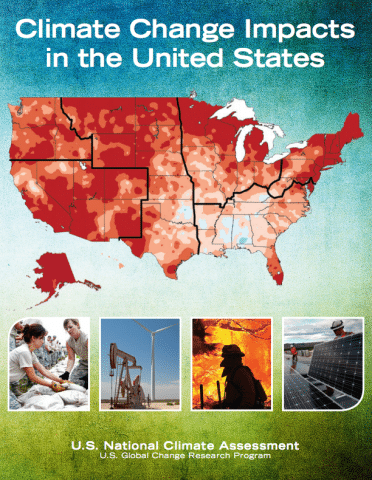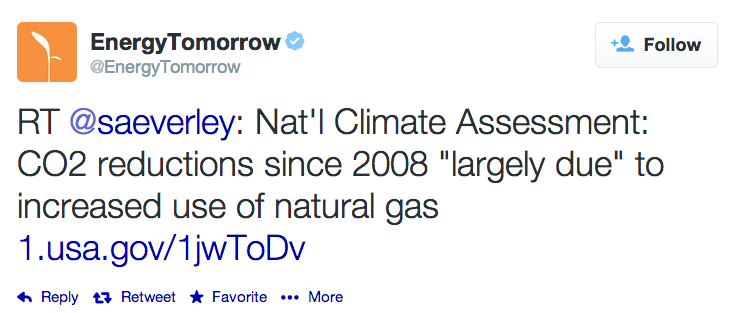Climate change is no longer a distant threat, but a clear and present danger. That’s the main takeaway from the third installment of the National Climate Assessment (NCA), released this week by the White House.
The report itself is a feat of both exhaustive climate science and creative science communications. The 840-page document is packed with illustrative graphics, and the web-based version features interactivity and video. Beyond painting the national picture, the NCA presents, in the words of White House science advisor John Holdren, “unprecedented detail about regional impacts” of climate change.
“Climate change is not a distant threat, but is affecting the American people already,” says Holdren in a video introducing the report. “Summers are longer and hotter, with longer periods of extended heat. Wildfires start earlier in the spring and continue later into the fall. Rain comes down in heavier downpours. People are experiencing changes in the length and severity of allergies. And climate disruptions to water resources and agriculture have been increasing.”
Some quick background: The U.S. Global Change Research Program was formed by Congressional mandate in 1990, and charged with producing regular “National Climate Assessments” in order to “highlight key knowledge that can improve policy choices and identify significant gaps that can limit effective decision making.” The NCA reports are compiled by a 60-member federal advisory committee made up some scientists, business leaders, and other climate experts, and the content itself is written by nearly 300 scientists, academics, government and private sector experts. The document itself is subjected to exhaustive review, including by the National Academy of Sciences. And as a consensus-based document, the findings must be approved by representatives of such disparate parties as environmental groups and fossil fuel companies. If anything, this report is conservative in its findings.
The big release
Rather than simply release the report as mandated, the White House is amplifying its alarming findings with its rollout. A two-hour livestream webcast on WhiteHouse.gov introduced the report, and featured eight meteorologists who are all a part of Climate Central’s Climate Matters program.
By featuring meteorologists, including a handful of local news weather forecasters, the White House put special emphasis on the sections of the report that show the present imprint of climate change on the weather that impacts us all. “Climate change, once considered an issue for a distant future, has moved firmly into the present,” the report said. “Corn producers in Iowa, oyster growers in Washington state and maple syrup producers in Vermont are all observing climate-related changes that are outside of recent experience.”
The White House is also linking the report’s findings to a handful of events later this week that address solutions to climate change. On Thursday, the administration will participate in the Better Buildings summit about energy efficiency, and White House advisor John Podesta said Monday that there would be some big announcements about solar deployment towards the end of the week.
From words on the page to action?
“I think this National Climate Assessment is the loudest and clearest alarm bell to date signalling the need to take urgent action to combat the threats to Americans from climate change,” John Holdren, the White House science advisor, said on a conference call.
Some see the high profile release of the NCA as part of an ongoing pivot by President Obama — which started, perhaps, in June of 2013 when he announced a formal Climate Action Plan that relies more on executive authority than on a deadlocked legislative branch — to more seriously address climate change in his last couple of years in office.
Yet for all the dire warnings issued by White House reps during the release of the NCA, and in the report itself, it remains to be seen whether the White House will address the threats with serious action.
Critics point to the massive expansion in hydrofracking, shale oil and natural gas production under this administration as contradictory to the rhetoric surrounding the lauded Climate Action Plan. And it would be hard to take the White House’s climate concern seriously if the release of the NCA is followed in a few months by approval of the Keystone XL pipeline, which fails the President’s own stated “climate test” by any fact-based measurement.
Predictable spin from fossil fuel industry
Of course, the fossil fuel industry and its apologists are always ready to pounce on any climate report, especially one promoted by the Obama administration.
Let’s start with Fox News. As noted by Media Matters, Fox News presented the release of this legally-mandated report as a “distraction” drummed up by the Obama administration to distract the American public. Fox News conveniently neglects the fact that the report was mandated by Congress and signed into law by former President George H.W. Bush in 1990.
Talk about actual distractions: Climate Depot, the in-house disinformation fountainhead of CFACT, opted to dismiss the NCA release by headlining the site with a piece penned by the consistently-debunked climate denier Christopher Monckton called “No Global Warming at all for 17 years 9 months” that cherry-picks data to hide actual long-term warming trends.
The American Petroleum Institute (API) didn’t comment on the report formally, but did manage to extract a self-serving talking point from the NCA:
The American Coalition for Clean Coal Electricity, fearing greenhouse gas regulations for power plants, dismissed the report as “unsubstantiated scare tactics and hyperbole.”
The Heartland Institute predictably piled on. James Taylor, a Senior Fellow at Heartland, offered this statement: “This laughably misleading report is the predictable result when hard-core environmental activists are chosen to write up a climate assessment for, and subject to the approval and revisions of, the Obama administration. It is like the punch line to a bad joke: ‘How many environmental activists does it take to put together an alarmist global warming report?’”
What Taylor and other climate deniers and delayers don’t mention is that the fossil fuel industries were well represented in the production of the NCA. Scientists from Chevron and ConocoPhilips, for example, were among those contributing to the report.
“Chevron recognizes and shares the concerns of governments and the public about climate change,” said Chevron spokesman Justin Higgs. “Chevron’s Arthur Lee was one of 60 committee members and 240 authors to assist in the compilation of this report. We recognize the importance of this issue and are committed to continued research and understanding.”
Realist reactions
Plenty of policitians and public figures responded to the NCA in a more realistic manner. Some highlights.
Washington Governor Jay Inslee, who just last week established himself as the country’s leading climate hawk governor, offered this statement:
“Today’s National Climate Assessment release further illustrates the costs that we know climate change is already having on Washington state, and the unacceptable dangers posed by a future without action to reduce carbon pollution…
“Fortunately, we have the knowledge and the tools to rise to this challenge. Washington state is uniquely positioned to lead in reducing carbon pollution, through the development of new clean energy technologies and increasing the energy efficiency of businesses and homes in our state. Last week I outlined a series of actions that our state will take together in the coming months to design a carbon-reduction and clean energy plan that will work best for Washington. And as climate change poses unique but certain threats to every region in the county, and world, I am glad to have a dedicated ally in President Barack Obama advancing his climate action plan at the federal level.
“This assessment confirms that the costs of inaction on climate change are unacceptable for our state, and our children’s future. This challenge is significant, but it is matched by tremendous opportunities.”
Secretary of Agriculture Tom Vilsack: “Across the country, farmers, ranchers and forest landowners are also seeing an increase in risks to their operations due to fires, increases in invasive pests, droughts, and floods. In the Midwest, growing seasons have lengthened, the western fire season is now longer, and forests will become increasingly threatened by insect outbreaks, fire, drought and storms over the next 50 years. These events threaten America’s food supply and are costly for producers and rural economies.”
Lyndsay Moseley Alexander, Assistant Vice President and Director, Healthy Air Campaign of the American Lung Association: “Today’s Assessment released by the Administration affirms what we’ve long known about the urgent need to address the health effects of climate change. Too often, the health impacts of climate are left out of the conversation. In the new National Climate Assessment, the message is clear: climate change threatens our ability to protect our communities, especially those most vulnerable, against the dangers of air pollution, increased allergens, extreme weather, and wildfire. We must meet the climate challenge now if we want to protect the health of millions of Americans living with asthma and other lung diseases, as well as children, seniors, low income and minority communities.”
Robert Cowin, Director of Government Affairs for Union of Concerned Scientists’ Climate and Energy Program: “The report clearly outlines the need to make climate resilience a national priority. We’re already feeling the impact of climate change and the costs are formidable. Ideally, we’d have a price on carbon to reduce emissions and help pay for climate resilience measures. In the meantime, Congress can do more to make infrastructure and industry less vulnerable to climate change and extreme weather.”
Carol Browner, Distinguished Senior Fellow at the Center for American Progress: “Once again the scientific community is sounding the alarm, this time with the National Climate Assessment, and reaffirming that carbon pollution is driving climate change, fueling more violent and frequent weather events, and threatening public health. The NCA underscores the urgency to address climate change and the biggest step the administration can take is to set the strongest possible limits next month when they unveil the first-ever limits on carbon pollution from existing power plants.”
Ken Berlin, President and CEO of the Climate Reality Project: “The National Climate Assessment drives home both the reality of climate change science and the impacts Americans are experiencing right now. As we pay more for groceries in the midst of record-breaking droughts, or rebuild after increasingly extreme weather events, or foot the healthcare bill for worsening air quality, it is clear that the cost of carbon pollution is real and growing.”
Lou Leonard, Vice President for Climate Change at the World Wildlife Fund: “This isn’t a typical climate report. Over the past several years, experts from around the country have contributed to and led its creation: local university professors, experts from state and local agriculture and water resources agencies, and leaders from the private sector. The report was created by America’s best and we need to use it to protect America’s communities and natural wonders.”
But don’t take their word for it. It’s well worth spending some quality time with the impressive interactive web-version of the report. Here are 12 major findings presented as highlights – from extreme weather to impacts on human health and agriculture. And if you want to explore how climate change is already effecting – and will continute to impact – your particular region, you can even zoom in directly to your home state.
Subscribe to our newsletter
Stay up to date with DeSmog news and alerts







